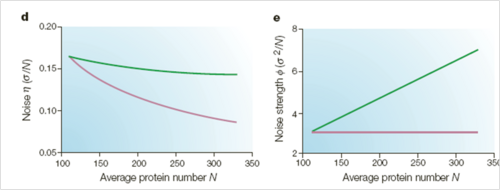Difference between revisions of "Translational Bursting"
From GcatWiki
| Line 9: | Line 9: | ||
()1 figure for translational bursting | ()1 figure for translational bursting | ||
[[Image:Protein_level_effects.png| 500 px]] figure for how TB is better than FNE | [[Image:Protein_level_effects.png| 500 px]] figure for how TB is better than FNE | ||
| − | <br> | + | <br><br><br> |
<center>[[Promoter Kinetics |Next Section in Origins and Characterization]] | [[Origins and Characterization of Stochasticity | Back to Origins and Characterization Home]]</center> | <center>[[Promoter Kinetics |Next Section in Origins and Characterization]] | [[Origins and Characterization of Stochasticity | Back to Origins and Characterization Home]]</center> | ||
Revision as of 20:10, 12 November 2007
Translational Bursting is the Main Source of Stochasticity in Prokaryotes
The amount of protein translated per strand of mRNA produced is a transcripts translational effciency or "burst parameter". Proteins are translated from mRNA in a pulsatile manner often described as "short bursting". Genes that are regulated by operons with low translational efficiency have a lower amount of noise than those exhibiting high translational efficiency. This is becuase a lower amount of mRNA in the cell means that the concentration of mRNA's be more susceptible to stochastic events such mRNA degredation.
Factors that Influence Translational Bursting
Degredation, get there when you come to it.
Results
()1 figure for translational bursting
 figure for how TB is better than FNE
figure for how TB is better than FNE